History remains that are still found in the south of Misiones Province. The architecture invites us to imagine the lives and poverty of inhabitants dwelling in a territory then divided. Our proposal is to travel along the Jesuit Missions Route of Misiones.
The Jesuit ruins are the vestiges of a fundamental transitional time in our country, during which very little was built and a lot was des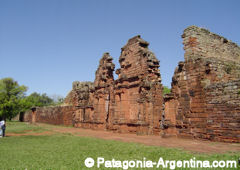 troyed; a society was wiped out to set the path for a new one.
troyed; a society was wiped out to set the path for a new one.
Nevertheless, this is the story of apeaceful colonization that, despite its negative aspects as the imposition of a culture, a religion and a language, has also succeeded in appeasing the suffering of native communities by considering its members as decent people who deserved education and an occupation, not as animals with no soul, who could be enslaved, as it was believed at that time.
The Origins
The settlements of native people converted to Christianity (reductions) founded by the Society of Jesus were established in 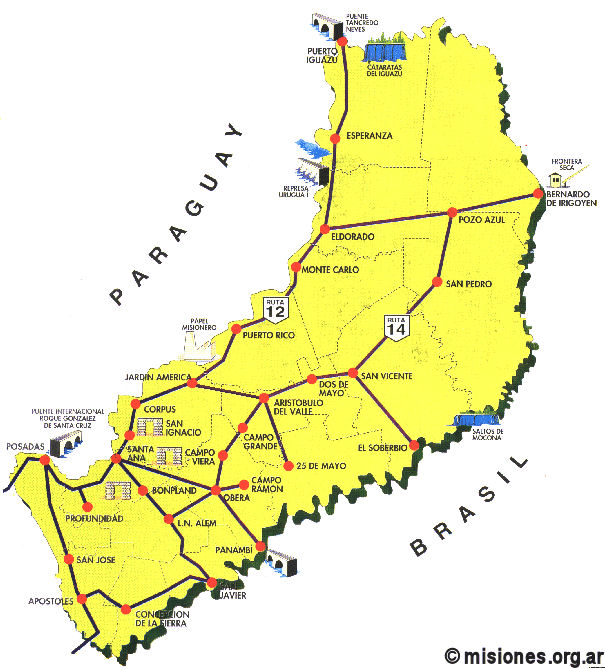 the 16th century with the purpose to evangelize. By that time, the Guarani people had reduced by half, after having suffered for 50 years not only the killing for fighting resistance but also the diseases brought by the European conquerors and abuse by the Spanish encomenderos1. Besides,moral and psychological violence due to subjugation had reached such an extreme point that women did not want to have children. What is more, the tekoas(communities in Guaraní) were destroyed by the dreadful bandeirantes, slave hunters from São Paulo (Brazil). By means of planned native work, it was possible to build a stable economic basis that caused numerous conflicts for labor force control. Its inhabitants subsisted and paid their tributes mainly through their agricultural production, and they also learned some manual skills.
the 16th century with the purpose to evangelize. By that time, the Guarani people had reduced by half, after having suffered for 50 years not only the killing for fighting resistance but also the diseases brought by the European conquerors and abuse by the Spanish encomenderos1. Besides,moral and psychological violence due to subjugation had reached such an extreme point that women did not want to have children. What is more, the tekoas(communities in Guaraní) were destroyed by the dreadful bandeirantes, slave hunters from São Paulo (Brazil). By means of planned native work, it was possible to build a stable economic basis that caused numerous conflicts for labor force control. Its inhabitants subsisted and paid their tributes mainly through their agricultural production, and they also learned some manual skills.
The Jesuits learnt how to take advantage of the myths and the native forms of organization in order to be accepted, although everything was ultimately controlled by the King’s authority. Regarding the local government, there was aCabildo, or town hall, at the main square of every Jesuit reduction with its own authorities, incl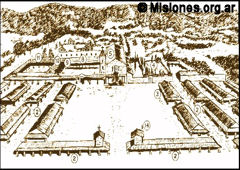 uding the corregidor2 and mayors, who were named by the governor. Nonetheless, the aboriginal chiefs(caciques) played a very important role, for they were direct intermediaries between Jesuit fathers and the native people.
uding the corregidor2 and mayors, who were named by the governor. Nonetheless, the aboriginal chiefs(caciques) played a very important role, for they were direct intermediaries between Jesuit fathers and the native people.
As regards education, reading and writing teaching was a significant democratizing step. Reductions even had the first printing press founded by fathers Juan Bautista Neuman and José Serrano, who built up a press and published the first books. The printings were done in Loreto, San Javier and Santa María la Mayor.
By an order of King Charles III of Spain, the Jesuits were expelled as from 1767. Over the time and after Paraguayan troops plunders, most of the reductions were devastated. However, it is possible to have a look at these impressive architectonic structures and the meaning felt behind their walls.
The Route Landmarks
Jesuit reductions in Misiones Province are distributed along the riverside of the Uruguay River and also near to the Paraná River: San Ignacio Miní, Loreto, Santa Ana, Corpus, Candelaria, San José, Apóstoles, Concepción, Santa María la Mayor, Mártires and San Javier. In the current Province of Corrientes: San Carlos, Santo Tomé, La Cruz and Yapeyú. The remaining 15 reductions were in Paraguayan and Brazilian territories, thus creating a group of 30 peoples organized under a European social structure but at the same time with a Guarani worldview.
In 1984, the Ruins of San Ignacio, Loreto, Santa María and Santa Ana in the Province of Misiones, and Yapeyú, Santo Tomé and San Carlos in the Province of Corrientes have been declared World Heritage by the UNESCO.
Nuestra Señora de Loreto Reduction
These ruins are located in the town of Loreto, 2 kilometers (1.2 mi) away from National Route No. 12 and 50 km (31 mi) away from Posadas. This reduction was created in 1632 but in 1686 it finally s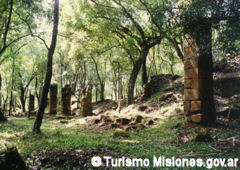 ettled at the Paraná riverside.
ettled at the Paraná riverside.
Its relevance then was due to its great production of yerba mate3 and linen and the mounting of the first printing press at that time, which was used to publish numerous books, many of them in Guarani language.
From under the trees, some walls and foundations barely protrude in this Jesuit place that has suffered many plunders and fires, causing the migration of its inhabitants and forest advancement, so there is little testimony of this reduction at present.
San Ignacio Miní Ruins
They are located in the very center of San Ignacio town, 60 km (37.3 mi) away from Posadas, the capital city of Misiones Province, on National Route No. 12. Due to their partial reconstruction and thanks to restoration and co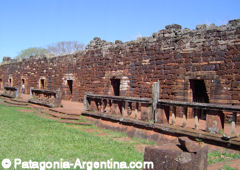 nservation efforts, these ruins let us go deep into the history of the missions between the 16th and 17th centuries.
nservation efforts, these ruins let us go deep into the history of the missions between the 16th and 17th centuries.
This settlement was founded in 1610 in Guayra, but it had to move to Paranaimá in 1655 due to the mamelucos4 attacks and then again, in 1695, towards where the ruins are currently located. It was named San Ignacio Miní to distinguish it from San Ignacio Guazú, which was founded before. “Miní” means “small” or “minor” in Guarani, and “guazú” means “big” or “greater”.
Although the city layout keeps the characteristics of the rest of the Jesuit reductions, i.e. a central squ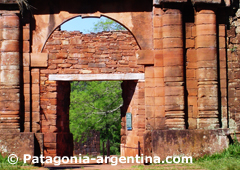 are, the Jesuit father house, the school, the cemetery, the houses, the cabildo (town hall), and the chapel, the church is especially outstanding.
are, the Jesuit father house, the school, the cemetery, the houses, the cabildo (town hall), and the chapel, the church is especially outstanding.
It had around 3300 inhabitants and the fact that it was close to the Paraná River allowed for active exchange with other reductions.
Today, a light and sound show is displayed at the central square to tell about life in the missions from their beginnings until their expulsion in 1768.
Santa María La Mayor Ruins
They are located in the San Javier-Itacaruaré Department, 120 km (74.5 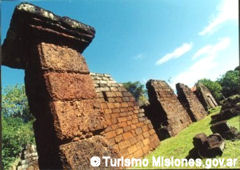 mi) away from Posadas, and they can be accessed by Routes No. 105/201/1/2.
mi) away from Posadas, and they can be accessed by Routes No. 105/201/1/2.
This reduction was founded in 1626 by father Diego de Boroa in the eastern region of the Paraná River, although it soon moved to the western shore of the Uruguay River, again due to thebandeirantes persecution in the area. In 1633, it settled near Santos Mártires del Japón reduction and, by the end of the 16th century, it moved to its current location, where it remained until its destruction (plundering and fire) in 1817 during the Portuguese invasions.
Santa Ana Reduction
These ruins are located in Santa Ana town, 700 m. (2,300 ft) away from National Route No. 12 and 40 km (25 mi) away from the city of Posadas.
The first reduction was founded in 1633 in the current Rio Grande 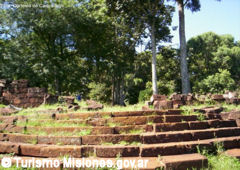 territory (Brazil) but also, due to the bandeirantes, two thousand Guaranís temporarily migrated to the High Paraná area, settling down definitely in its current location in 1660. In spite of the advancing forest, we can see the central square, the Church, houses, workshops and the cemetery, which was later used by the first inhabitants of Santa Ana. Besides, we can observe productive structure of this reduction, the watering system, city lots, vegetable gardens and staggered irrigation system. The special feature is the sequence of squares and plazas contrasting the urban model of the other reductions.
territory (Brazil) but also, due to the bandeirantes, two thousand Guaranís temporarily migrated to the High Paraná area, settling down definitely in its current location in 1660. In spite of the advancing forest, we can see the central square, the Church, houses, workshops and the cemetery, which was later used by the first inhabitants of Santa Ana. Besides, we can observe productive structure of this reduction, the watering system, city lots, vegetable gardens and staggered irrigation system. The special feature is the sequence of squares and plazas contrasting the urban model of the other reductions.
Precisely, a shared architectural feature is that construction used to be unstable and simple using adobe, rammed earth and straw in the f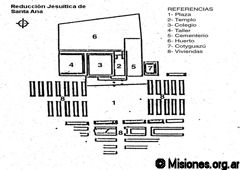 oundation and layout stage. By the end of the 17th century, after the defeat of the bandeirantes in the battle of MBORORÉ in 1641, every city definitely settled and got organized based on an urban project where buildings were made of stone and local wood, and this is basically what can be seen today in these ruins.
oundation and layout stage. By the end of the 17th century, after the defeat of the bandeirantes in the battle of MBORORÉ in 1641, every city definitely settled and got organized based on an urban project where buildings were made of stone and local wood, and this is basically what can be seen today in these ruins.
In general, the region has a good infrastructure for tourism and facilities for outdoor activities. In all cases, there are museums that preserve numerous testimonies that have been collected from excavations.
Footsteps for Thought
Jesuit missions have disappeared; they were wiped out by an order issued by someone higher in rank. Was it fair? Was it absurd? It can be discussed. But there is no doubt that those living ruins, which are fighting to survive the advancing forest, are an invitation to think over. Jesuit missioners wanted to evangelize the Guaraní, and they did it in a very particular way. They chose to rescue their habits and beliefs and give them a new meaning. This is the reason why today we can read in those ruins, as in a palimpsest, the major features of the Guaraní culture.
And we can go further and even have the audacity to think that the merging, the mixture or the “contamination” resulted into a powerful force that has survived the passage of time. This gives us something to think about in these times of so much rejection to immigration, of so much fear to alleged invasions…
This is definitely a necessary visit when there is a chance to meet the Argentine Northeast – Mesopotamia region.